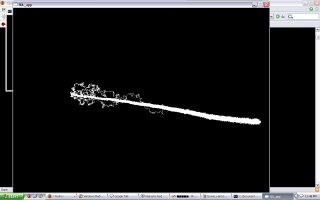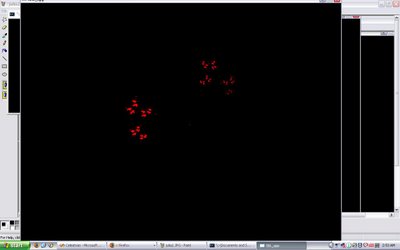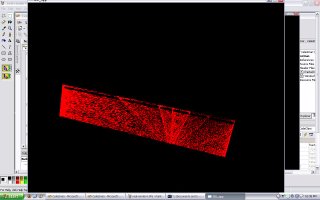Heading "Home"
Labels: snippet
You are entering a world where logic knows no bounds. A world where the 4 familiar dimensions of time and space are eschewed for mind bending alternatives. A world where the ring that your coffee left on the veneer of your desk might be another universe or something. Welcome to the world of max's brain!
Labels: snippet
I am going to start using this blog more as a muse on the nature of video game design and production rather than an investigation of fractal concepts. Note that I will most likely continue to mention fractals here and there, as I feel strongly that the nature of fractals is inextricably linked to game theory.
As our little game progresses (mySims for those who don't know what I am working on), we are starting to see some very profound developments in terms of overall message and theme. I was having some interesting discussion with our lead designer about the nature of feedback from a game system and the unique educational possibilities that emerge from the unique relationship between player and game. Here is what I believe to be an important excerpt from that conversation:
"I think games have the power to be compelling and enlightening beyond the point of anyone’s wildest expectations. “Karma” is an extremely sublime concept, but it is true and real and exists in a very real sense, on a personal, societal, and universal level.
Real life karma comes in a few flavors, depending on how spiritual you are willing to go, but, at the most grounded, personal level, it exists as an internal pressure that comes from inherent recognition of morality in our choices. When we do bad things (destructive, chaotic), it poisons us from the inside, making us feel worse about ourselves and further disconnecting us from future choices (I have a theory that all chain-reactions are either positive or negative feedback loops. True self-regulation is generally temporary). This has the effect of introducing additional chaos and decay into our lives. On the other hand, when we do good things (constructive, orderly), it enforces order internally as well, which increases our ability (and, I would argue, tendency) to maintain balance and further refine the structure of our thinking.
This is what interests me as a game developer. If I can produce art which both increases people’s ability AND tendency to create and order their environment, I can affect the order of reality as a whole far beyond my small physical limits as one human being. Thus we can use games as a FULCRUM to multiply the power of our minds.
If we make games that act as caricature for karma, we can help people to realize the intricate, interlocking system of dependency that is their daily existence. Through this illustration, we can introduce the realization that not only do choices matter, but that 1) the nature of choice is deeply entwined with the fabric of reality and 2) even the simplest of choices can affect massive change throughout the system."
What I am getting at here is, basically, that games are in a unique position to act as a mirror for a player. Think back to Ender's fantasy game. That game acted at once as a playmate and counselor, providing fun experiences each packed full of intense purpose and significance. Art in other mediums can be profound, but it is always static with respect to its viewer. Considering that choice is such a significant element of our existence as human beings, very few forms of art really have the ability to reflect the potency and duality of a dilemma. Because of the unique nature of the medium of interactive video games, we DO have the ability to reflect this significance. In games, we have unique methods to present the player with his/her own dilemma, and then show the aftermath of changes and evolution of states that follows.
Using dilemmas, game developers can truly illustrate existence without predisposition. Instead of warning against the dangers or extolling the virtues of a specific choice, we can instead show the very nature of choice itself, and provide more of a TEMPLATE for thinking rather than a library of example data. This is the difference between a flight manual and a simulation.
-Max
Labels: game design


 Here is a newer variation. The particles spawn all around the camera and have random lifespans. The darker lines are the paths of near-dead particles.
Here is a newer variation. The particles spawn all around the camera and have random lifespans. The darker lines are the paths of near-dead particles.











Scott Cronce told me that EA can afford to produce two “risk games” each year. These “risk games” are defined as games that do not closely follow the archetype established by a previously successful archetypal game. Spore is one of those games.
What is really interesting is this: the only reason that EA can afford to gamble on 2 high risk ventures per year is that they produce so many bland, lifeless rehashes. Not that these games are bad, in fact I believe that the vast majority of EA games are in the “good” category, they are just unimaginitive. For those of us that highly value imaginitive games (which Luke, Namaste, and myself certainly consider ourselves to be), this means that we can get what we want (spore) but only as long as the people who dont value imaginitive games (see anyone who obsessively plays counterstrike) also get what they want.
It is only because there are millions and millions of people paying 50 dollars for a coat of new paint on Madden each year that Spore exists in the first place.
Make whatever you will of this situation, but I see it as a good stepping-stone towards the time when virtually all gamers have seen the light and when game companies can make only great, original, high-quality games (and I believe that this is EA's long term philosophy also). If game companies can get enough creative games out the door, I believe that a paradigm shift will take place. Eventually, after playing many games like Oblivion, the public will refuse to pay so much for the next version of Madden. It certainly doesnt cost as much to produce Madden ‘06 as it does to produce Oblivion, yet they cost the same.
Only truly ignorant gamers (read 99% of the gaming population of Earth) will continue to pay more for less. Eventually, even a process as slow as natural selection will run its course.
Projection: Either we have a speciation of gamers into Homo-sapiens and Neo-sapiens, or we convince all those who play mediocre games every day to get a clue. I think the movie industry is going through the same growing pains right now. We are smarter, though, cause it took them nearly a century to figure it out
Imagine that you came up with this great experimental game idea that would most definitely produce emergent behavior. You work on one version with 10 million dollars and you produce an amazing skeleton of goodness. You ship it out there or zap it to the nets, and people eat it up. It's good stuff and everyone is in to it.
Now go back in time and imagine if you started the same project with 200 million dollars. You could develop the same code and then, at the very least, buy a boatload of supercomputers and a small building to put them in. You set up your system on the computers and let it run for half a year, THEN you release it. With the extra manpower that you could afford on the side, you could probably complete the whole process in the same amount of time.
The amount of content that would be produced with the second model would be exponentially larger than the original. People would have a ridiculously huge would to explore right from the getgo. When you come into the world, it is fully formed for the most part. You can create your works and then you die, but you dont start out in a void, or a nearly blank canvas. Now, I agree that there could be an amazing design that did start with a blank canvas on purpose, and it could still be a mode in the second version, but you would also have the other crazy computer-rendered world there for those who wanted to explore it.
I think the projects that you are working on will eventually lead there, as I hope mine will, but what we hope for is a SYNTHESIS of the two. The games industry is massive, and it can easily support a full cornucopia of ridiculous games in only a few years. If we can get the major studios and the major funding sources towards the good stuff, then we win. Gamers everywhere win, and the payoff will be big-time.
I hope your goal is to create the stuff at the beginning, but work towards something larger, something bigger than what exists elsewhere. To do something like that you need people. Our civilization is what makes us strong, and if you get a bunch of brilliant artists together the result is magic.
 UPDATE: Luke Palmer helped me fix the problem, and now the distribution looks uniform!
UPDATE: Luke Palmer helped me fix the problem, and now the distribution looks uniform! *UPDATE*: I was falling asleep last night, when the thought struck me that I should show the path of the particle as opposed to a cloud of points. It seems so *$%#&ing obvious to me now that I can't imagine how I didnt think of it this way to begin with. After I implemented the path trace (see above rendering), I thought back to my CAGD class (Computer-Aided Geometric Design) and remembered b-splines. The idea of a b-spline is to extend a Bezier curve into a long "frankenstein" curve that is a concatenation (and combination) of any number of Bezier curves into one composite curve, which is defined by the control points and a sequence of knots which define the time spent in each portion of the curve (which basically means "how fast the particle is moving through the various sections of the curve"). This technique is used extensively in computer animation, for example Pixar films. The animators use a b-spline to trace the path of an object through the virtual world, like a ufo flying through space, and the knot sequence determines the acceleration and speed of the ship through the various turns, twists, and straights.
*UPDATE*: I was falling asleep last night, when the thought struck me that I should show the path of the particle as opposed to a cloud of points. It seems so *$%#&ing obvious to me now that I can't imagine how I didnt think of it this way to begin with. After I implemented the path trace (see above rendering), I thought back to my CAGD class (Computer-Aided Geometric Design) and remembered b-splines. The idea of a b-spline is to extend a Bezier curve into a long "frankenstein" curve that is a concatenation (and combination) of any number of Bezier curves into one composite curve, which is defined by the control points and a sequence of knots which define the time spent in each portion of the curve (which basically means "how fast the particle is moving through the various sections of the curve"). This technique is used extensively in computer animation, for example Pixar films. The animators use a b-spline to trace the path of an object through the virtual world, like a ufo flying through space, and the knot sequence determines the acceleration and speed of the ship through the various turns, twists, and straights.
























